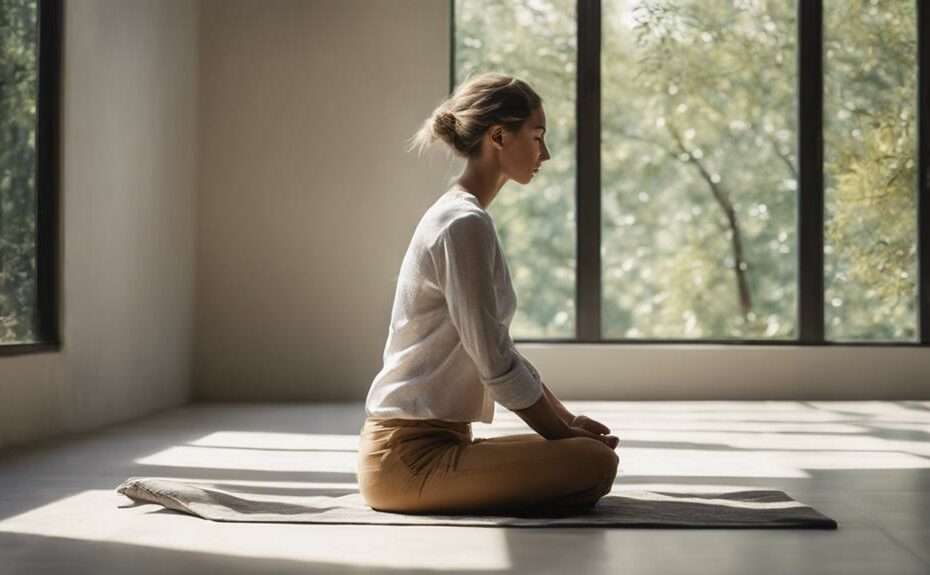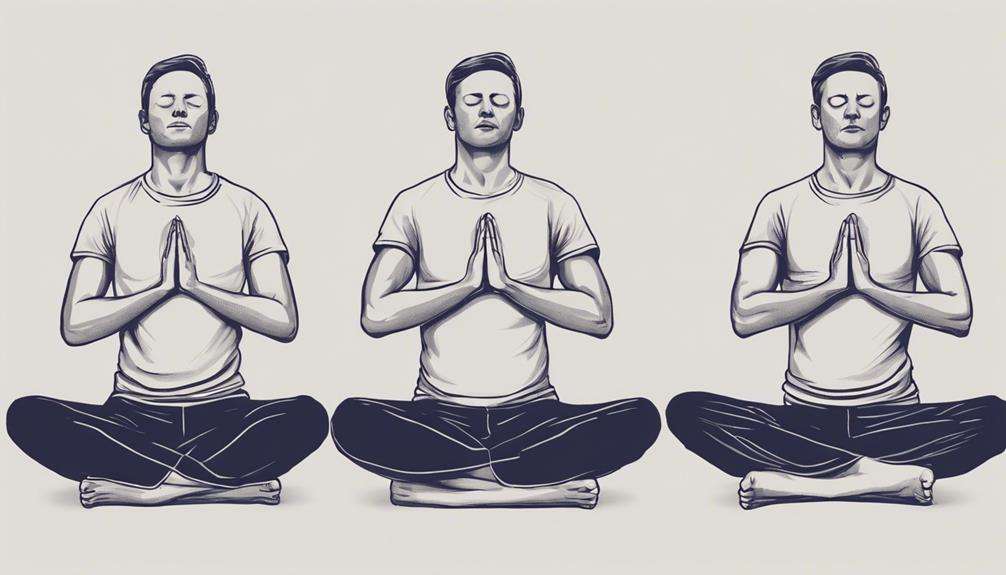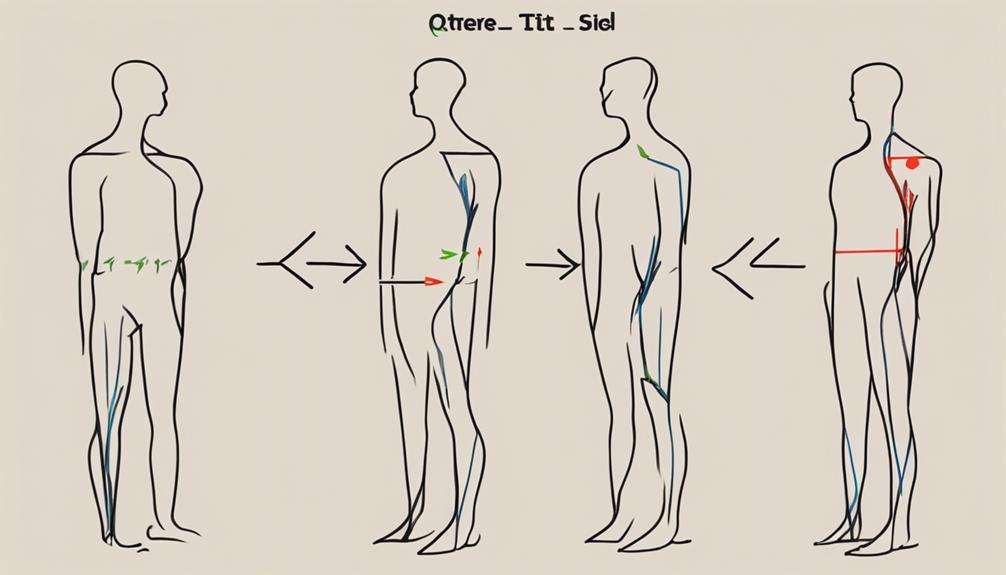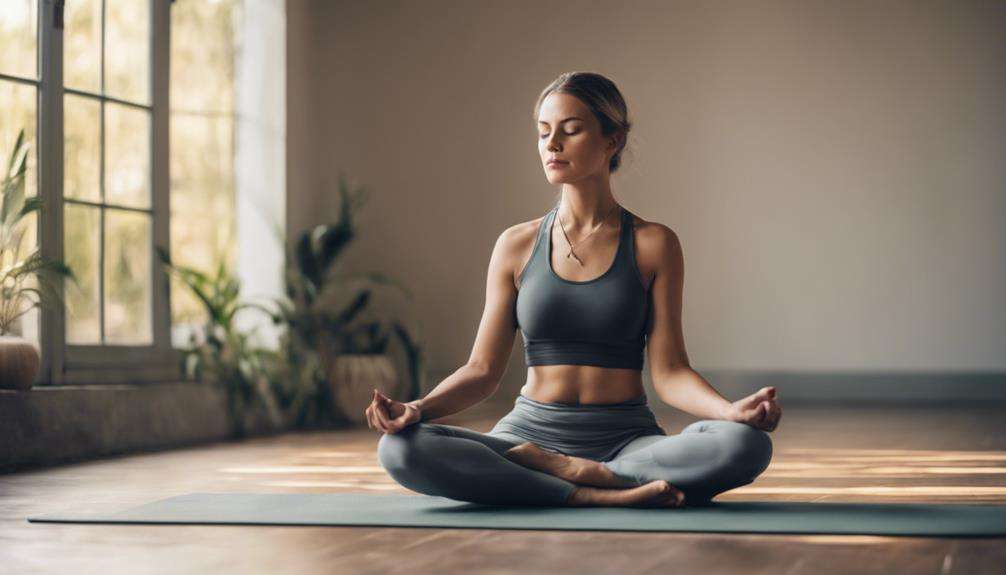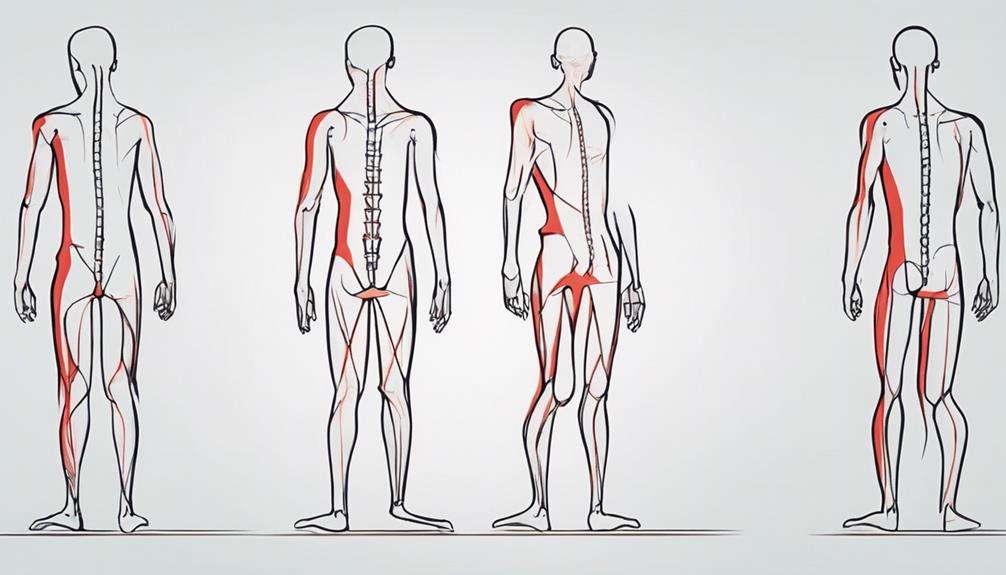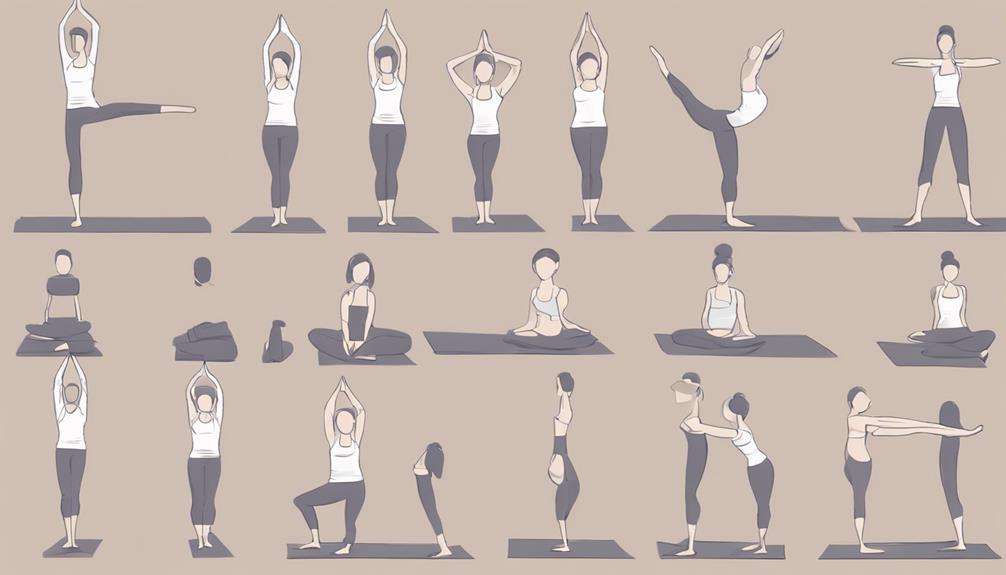When it comes to enhancing your posture through meditation techniques, incorporating various seated positions can notably impact your alignment and overall well-being.
From engaging core muscles to relaxing shoulders and softening face muscles, each technique offers unique benefits that contribute to a more mindful practice.
By exploring these methods, you can discover a holistic approach to improving your posture and experiencing greater comfort and stability during meditation sessions.
Key Takeaways
- Engage core muscles for stability and improved posture.
- Relax shoulder and neck muscles through breathing and stretching.
- Open the chest and heart space for better alignment.
- Ground through feet, stabilize hips, and activate back muscles for posture support.
Sitting With Proper Spine Alignment
To achieve proper spine alignment while meditating, make sure your back is straight and elongated, engaging your core muscles to support a strong and upright posture. Sitting with importance is fundamental for a successful meditation practice.
Imagine your spine as the central axis of your being, rooting you to the present moment. Feel the natural curves of your spine settling into place as you sit with awareness. Your core muscles act as the foundation of this alignment, gently pulling you upwards while keeping you grounded.
Engaging Core Muscles for Stability
As you explore engaging your core muscles for stability during meditation, you'll find a deeper connection to your body's center.
By incorporating core activation into your practice, you can cultivate a strong foundation that promotes better posture and alignment.
Strengthening these muscles offers a pathway to enhanced body awareness and mindfulness as you sit with intention and stability.
Core Muscle Importance
Engage your core muscles mindfully during meditation to cultivate stability and support for your spine, enhancing your posture and overall well-being.
By activating your core muscles, you create a solid foundation that prevents slouching and promotes an upright sitting position during meditation. This engagement not only reduces strain on your back and shoulders but also improves body awareness and alignment, making your meditation experience more comfortable.
Strong core muscles developed through meditation practice have a significant impact on your overall posture and physical well-being. So, remember to focus on your core activation as you meditate, feeling the stability it provides and the positive effects it has on your posture and body alignment.
Exercises for Stability
By focusing on strengthening your core through targeted exercises, you can enhance stability and support for your spine during meditation sessions. Engaging your core muscles is essential for maintaining proper meditation posture. Practice abdominal bracing by gently drawing your navel towards your spine to stabilize the spine and pelvis.
Strengthening deep core muscles like the transverse abdominis can provide better support for your posture. Incorporate exercises such as planks, bird dogs, and bridges into your routine to improve core strength and stability.
Building a strong core will help you prevent slouching and maintain an upright posture, allowing you to meditate with ease and comfort. Remember, a stable core is the foundation for a balanced and aligned meditation practice.
Benefits of Engagement
Strengthening your core muscles during meditation not only enhances stability and posture alignment but also fosters a deeper sense of body awareness and mindfulness. By engaging your core, you create a solid foundation that supports your spine, reducing the risk of slouching and discomfort.
This activation brings a heightened awareness to your body, allowing you to tune into subtle cues and adjust your posture accordingly. As you focus on engaging your core muscles, you cultivate mindfulness, staying present in the moment and connected to your body's alignment.
This connection not only benefits your posture during meditation but also carries over into your daily activities, promoting a more stable and aligned body throughout the day.
Shoulder Relaxation Techniques
As you begin to explore the domain of shoulder relaxation techniques, remember that simple movements like the shoulder roll exercise can release built-up tension.
Incorporating gentle neck stretching techniques can further enhance your journey towards relaxation and improved posture.
Engage in deep breathing practices to cultivate a sense of calmness that resonates through your shoulders and entire being.
Shoulder Roll Exercise
To enhance your posture and release tension, engage in the shoulder roll exercise, a simple yet effective technique that involves circular movements of your shoulders.
Start by ensuring your spine is straight while sitting or standing, and let your hands rest comfortably on your thighs. Inhale deeply as you lift your shoulders towards your ears, then exhale as you roll them back and down smoothly.
Repeat this movement 5-10 times to relax your shoulders, open up your chest, and align your spine. By incorporating the shoulder roll exercise into your daily routine, you can increase body awareness, reduce stiffness, and promote better posture.
Take a moment to connect with your body through this mindful practice, allowing yourself to feel the benefits of improved posture and relaxation.
Neck Stretching Techniques
Engage in gentle neck stretching techniques to release tension in your shoulders and enhance your overall posture.
Start by sitting comfortably with your back straight and relaxed. Close your eyes to focus inward, and place a cushion under your hips for added support.
Slowly tilt your head to one side, feeling the stretch along the opposite side of your neck. Hold for a few breaths, then switch to the other side.
Next, gently rotate your head in circular motions, allowing the neck muscles to loosen. Shoulder rolls and shrugs can complement these stretches, promoting muscle relaxation and better alignment.
Incorporating these neck stretches into your daily routine can prevent discomfort and support a more relaxed, upright posture during meditation sessions.
Breathing for Relaxation
Practice deep breathing exercises to cultivate relaxation in your shoulders and release tension in your upper body, fostering a harmonious balance within yourself. When in comfortable meditation positions, focus on inhaling deeply through your nose, expanding your chest and diaphragm, and exhaling slowly through your mouth.
Incorporate shoulder rolls and stretches to loosen tight muscles and improve posture. Mindfully observe any discomfort or tightness in your shoulders, consciously releasing it with each breath.
Regularly integrating shoulder relaxation techniques into your routine can enhance overall relaxation, promote better posture, and support a more comfortable meditation experience. Remember, the key is to breathe deeply, be present in the moment, and let go of any tension you may be holding onto in your shoulders.
Chin Tucking for Neck Support
When aligning your posture for meditation, gently bring your chin towards your neck to support your spine and reduce strain on your neck muscles. Chin tucking is a simple yet effective technique that promotes proper posture alignment, allowing the head to sit directly above the spine. By adopting this posture adjustment, you can alleviate tension in the upper back and shoulders, enhancing your overall comfort during meditation sessions.
Furthermore, practicing chin tucking regularly can lead to improved posture awareness, helping you prevent slouching and neck pain. This mindful adjustment not only supports better breathing and circulation but also contributes to a more relaxed and centered meditation experience. As you sit with your chin gently tucked, you create a stable foundation for your neck and spine, enabling you to sit comfortably for extended periods without discomfort. Embrace the practice of chin tucking as a way to nurture your body and mind during meditation.
Opening the Chest and Heart Space
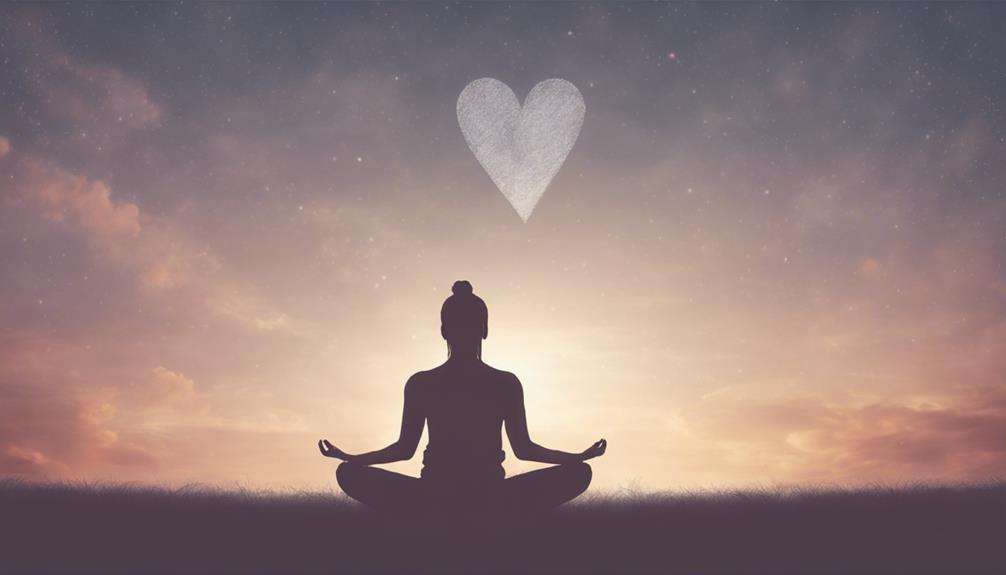
As you focus on opening the chest and heart space in your meditation practice, you invite a sense of expansion and release in your upper body.
By gently rolling your shoulders back and down, you create room for deeper breaths and improved alignment.
Embracing this technique can enhance your posture, alleviate tension, and cultivate a more confident and open presence during meditation.
Chest Opening Benefits
Enhancing your meditation practice with chest opening techniques fosters a sense of physical and emotional well-being. When sitting cross-legged, incorporating chest opening stretches into your routine can lead to improved posture. These stretches help reduce tension in the shoulders, upper back, and chest muscles, aiding in correcting posture misalignments.
By opening your chest, you enhance lung capacity and oxygen intake, promoting better breathing patterns. This not only boosts your physical well-being but also increases confidence, reduces slouching, and prevents back pain. Moreover, the enhanced heart space openness cultivated through these practices can foster feelings of compassion, love, and emotional well-being.
Regularly practicing chest opening techniques can also increase energy flow, vitality, and overall physical wellness.
Heart Space Exercises
To cultivate a sense of openness and alignment, engage in heart space exercises focusing on expanding the chest and heart center. Start by sitting on the floor with your legs crossed comfortably on a meditation cushion.
As you settle into this position, bring awareness to your breath and gently roll your shoulders back. Slowly lift your chest towards the sky, feeling a gentle stretch across the front of your body. Allow your heart space to open with each inhale, creating space for deeper breaths and increased energy flow.
These exercises help release tension in the upper body, promoting a more upright posture during meditation. Embrace this practice regularly to enhance your posture and cultivate a deeper connection to your heart center.
Grounding Through the Feet
Feel the grounding connection with the earth's energy through your feet as you settle into your meditation practice. Position yourself comfortably, ensuring your feet are firmly planted on the ground. Grounding through the feet is a fundamental practice that can enhance your meditation experience. By focusing on the pressure and sensation in the soles of your feet, you can cultivate a deeper sense of mindfulness and presence. Engage the muscles in your feet and legs, allowing them to support your body and improve your posture. This connection with the earth's energy not only stabilizes your body but also promotes a feeling of rootedness and balance within.
As you ground through your feet, you're supporting the proper alignment of your spine and releasing any tension stored in the body. This grounding technique is essential for maintaining stability and comfort during meditation. Embrace the sensation of being connected to the earth, allowing it to center you and bring a sense of peace to your practice.
Maintaining Hip Alignment and Stability
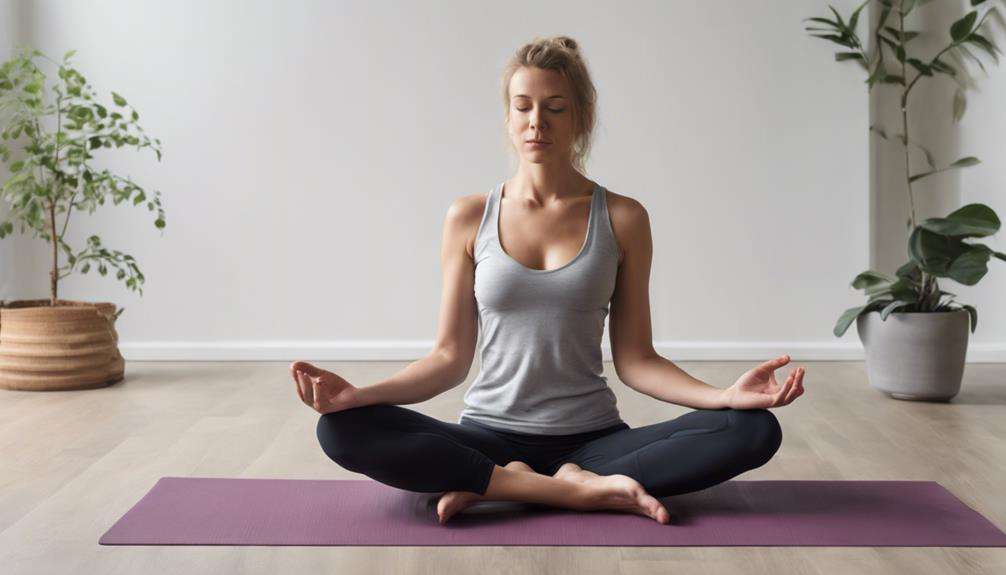
As you settle into your meditation practice, ensuring proper hip alignment and stability is essential for preventing lower back pain and supporting a straight spine.
When in a seated position, particularly in a cross-legged position, focus on aligning your hips evenly to distribute weight symmetrically. Engage your core muscles gently and connect with your sitting bones to stabilize your hips. You can enhance hip alignment by using cushions or props under your hips to elevate them slightly, helping you find a comfortable position that supports your spine.
Mindfully adjusting your hip position during meditation allows you to strike a balance between stability and ease. By maintaining hip stability, you improve weight distribution and reduce strain on your lower body during longer meditation sessions.
Prioritizing hip alignment and stability not only benefits your posture during meditation but also contributes to an overall more comfortable and sustainable practice.
Activating the Back Muscles
Engage your back muscles by gently squeezing the shoulder blades together to support a straight spine and enhance your meditation posture. By activating these muscles, you create a stable foundation that prevents slouching or hunching over during your meditation practice.
Focus on drawing your shoulders back and down to not only maintain proper alignment but also to open up your chest, allowing for deeper, more mindful breathing. Strengthening your back muscles through this intentional engagement can also help alleviate any tension or discomfort in the upper body that may arise during long periods of sitting.
With consistent practice, you'll notice an improvement in your overall posture and body awareness during meditation sessions. Embracing this technique as part of your routine won't only benefit your meditation practice but also contribute to a more mindful and comfortable posture throughout your day.
Relaxing and Softening the Face Muscles
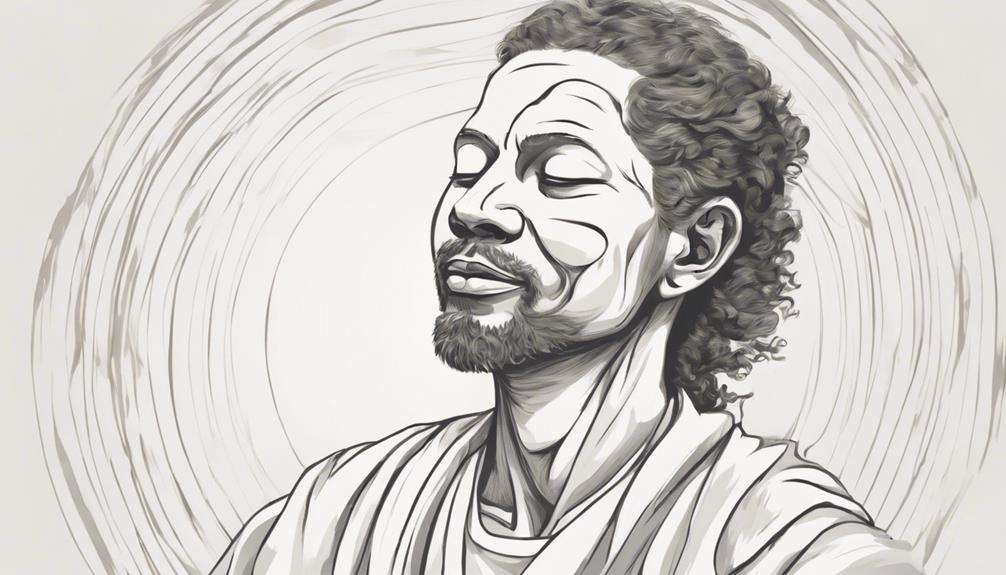
To further enhance your meditation posture and promote relaxation, consider focusing on loosening and softening the facial muscles. Begin by consciously softening your forehead, allowing any tension to melt away. Relax your jaw by gently parting your teeth and letting your tongue rest at the bottom of your mouth.
Smooth out any furrows between your eyebrows by consciously relaxing that area. Loosen your cheek muscles by starting with a gentle smile and then letting your face settle into a neutral expression. Finally, release tension in your eyes by gently closing them and allowing your eyelids to feel light and soft.
Enhancing Posture Awareness Through Meditation
Enhance your awareness of posture through meditation by cultivating mindfulness towards your body alignment and breath. When you meditate with your eyes closed, focus on aligning your spine, shoulders, and hips. Pay attention to the natural curves of your spine and gently adjust to maintain proper posture awareness.
Mindful breathing plays an important role in supporting your posture; as you breathe deeply, visualize your breath traveling through your body, lifting your chest and elongating your spine. With regular practice, meditation can help reduce muscle tension and promote a more upright stance.
During meditation, bring awareness to any areas of tension or discomfort in your body. By acknowledging these sensations, you can release them and prevent them from affecting your posture negatively. Incorporating mindfulness into your daily routine through meditation won't only enhance your posture awareness but also contribute to your overall well-being.
Frequently Asked Questions
Can Meditation Improve Posture?
Yes, meditation can improve posture through enhancing the mind-body connection, increasing alignment awareness, and strengthening core muscles. Regular practice fosters relaxation, reducing tension that impacts posture. Embrace these benefits for better alignment and comfort.
How Do I Keep My Back Straight While Meditating?
To keep your back straight while meditating, engage your core for proper alignment, support spinal health, and enhance core strength. Imagine a puppeteer guiding your head skyward to maintain a tall and relaxed posture.
Why Sit Cross Legged During Meditation?
Sitting cross-legged in meditation offers benefits like stability and improved focus. It encourages a straight spine, reducing slouching. Alternatives exist, but this position fosters mindfulness and connection with the earth. Embrace the challenges for a deeper practice.
Can I Slouch While Meditating?
You'll find discomfort, hindered energy, and distraction when you slouch while meditating. Embrace mindful sitting, prioritize spinal alignment, and avoid slouching consequences. Your practice thrives with a straight spine, fostering relaxation, focus, and deep breathing.
Conclusion
So there you have it, 10 meditation techniques to improve your posture and enhance your overall well-being.
While it may seem challenging to maintain proper alignment at first, with practice and patience, you can gradually strengthen your body and mind.
Remember, it's normal to experience some discomfort initially, but by listening to your body and making adjustments as needed, you can make the most out of your meditation practice.
Embrace the journey towards better posture and inner peace.
